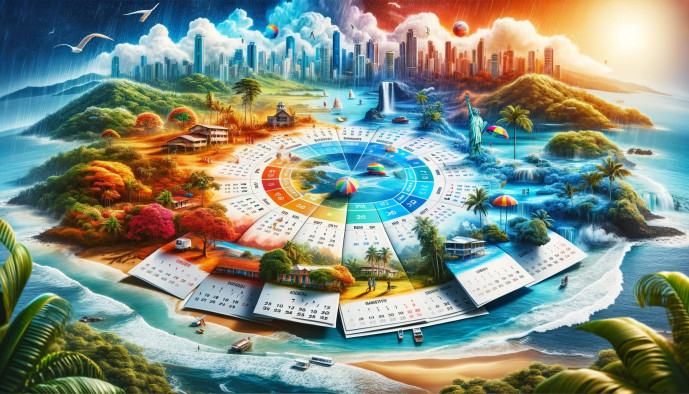Best time to visit Panama
Discover the ideal season for Panama's beaches, wildlife, and festivals in our travel guide.

Essentials
Understanding Panama’s Two Main Seasons
The most important factor in planning your journey is understanding Panama’s distinct seasons. There is no “bad” time to visit, as each period offers a unique experience. We refer to the rainy season as the “Green Season” for a reason—it is when the country’s natural beauty is at its most vibrant.
The Dry Season: Mid-December to April
This period is Panama’s “summer” (verano) and is the most popular time for travelers. You can expect abundant sunshine, clear blue skies, and higher temperatures with very little chance of rain.
- Pros: The weather is ideal for beach relaxation, sailing through the San Blas or Pearl Islands, exploring Panama City’s historic districts, and hiking on well-maintained, mud-free trails.
- Cons: As this is the peak tourist season, you will encounter larger crowds at popular destinations. Prices for flights and accommodations are typically at their highest during these months.
- Key Events: The Panama Jazz Festival takes place in January. Carnival, held in February or March, is a spectacular, country-wide celebration. Be aware that it is a massive, vibrant party, which also means many businesses close and transportation between cities can be challenging.
The Green Season: May to Early December
The landscape becomes exceptionally lush and vibrant during these months. Rain is a regular occurrence, but it typically arrives in short, intense downpours in the afternoon, leaving the mornings sunny and clear for exploration.
- Pros: With fewer tourists, you can often find lower prices on flights and hotels. The rainforest is breathtakingly beautiful, and wildlife is particularly active. It is an excellent season for birdwatching, as the Resplendent Quetzal nests from March to July. The Pacific coast also sees its best surfing conditions.
- Cons: The humidity is noticeably higher. In very remote areas, such as parts of the Darién, some unpaved roads may become temporarily impassable. Sea travel to certain islands can also be rougher than during the dry season.
- Key Events: November is filled with national holidays and independence celebrations. We advise clients that multiple public holidays during this month can affect the operating hours of banks and other businesses.
A Quick Month-by-Month Guide
Here is a concise summary to help you quickly reference the conditions during your travel dates.
- January – March: This is the peak of the dry season. These are the hottest, sunniest, and most popular months to visit. We recommend booking all accommodation and tours well in advance.
- April: A transitional month. It remains mostly dry, though the first rains may begin to appear toward the end of the month. Holy Week (Semana Santa) can be a very busy period for domestic travel.
- May – August: The Green Season is underway. Expect bright, sunny mornings perfect for activities, followed by refreshing afternoon showers. The country’s landscapes are exceptionally green and full of life. This is a fine time to find good value and avoid crowds.
- September – October: These are historically the wettest months. Rain can be more frequent, making this the official low season. It is an ideal time for budget-conscious travelers who appreciate the rainforest at its most dramatic. Note that the Caribbean side, particularly Bocas del Toro, often experiences a “mini-dry season” during this time with calmer, sunnier weather.
- November: While still rainy, the country has a festive atmosphere due to numerous national holidays celebrating its history. The entire month is known as “Mes de la Patria” (Month of the Homeland).
- December: Another month of transition. The rains begin to subside around the middle of the month as the dry season approaches. It is a wonderful time to see the landscape shift from lush green to gold. Holiday travel increases significantly in the last two weeks.
Best Time for Your Specific Interests
To make your planning more practical, here is advice tailored to different activities and itineraries.
For Beach Time & Island Hopping (San Blas, Bocas del Toro)
- Best: The dry season from mid-December to April offers the calmest seas and most reliable sunshine, which is particularly important for boat travel and enjoying the idyllic beaches of the San Blas Islands.
- Good to know: Bocas del Toro, on the Caribbean coast, follows a different weather pattern. It can be an excellent destination in September and October, when much of the Pacific coast is experiencing heavy rain.
For Hiking & Wildlife Viewing (Boquete, Darién)
- Best: The beginning of the Green Season, from May to July, is exceptional. The rainforest is thriving, wildlife is very active, and the rains have not yet reached their peak. This is also the prime season for spotting nesting Resplendent Quetzals in the highlands near Boquete.
- Good to know: The dry season is also perfectly suitable for hiking, as the trails will be drier and easier to navigate, though the environment will not be quite as lush.
For Surfing
- Pacific Coast: The Green Season, from approximately May to November, delivers the largest and most consistent swells to Panama’s Pacific beaches.
- Caribbean Coast: The pattern is reversed here. The best and most powerful waves typically arrive during the dry season, from December to March.
For Panama Canal & City Exploration
Any time of year is fine for visiting the Panama Canal and exploring Panama City. The dry season arguably offers the most comfortable conditions for walking around the city’s neighborhoods and guarantees clear views of the canal. During the Green Season, you can easily enjoy these attractions by planning your outdoor activities for the generally clear and sunny mornings.